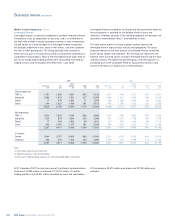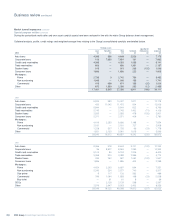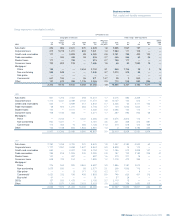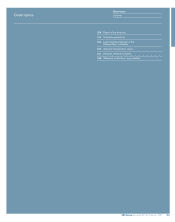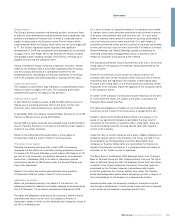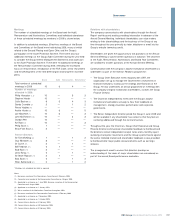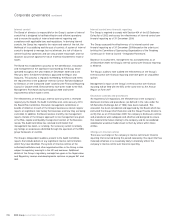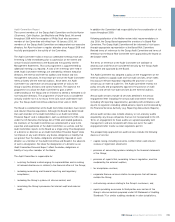RBS 2009 Annual Report Download - page 211
Download and view the complete annual report
Please find page 211 of the 2009 RBS annual report below. You can navigate through the pages in the report by either clicking on the pages listed below, or by using the keyword search tool below to find specific information within the annual report.
209RBS Group Annual Report and Accounts 2009
Governance
Risk factors
The Group’s future performance and results could be materially different
from expected results depending on the outcome of certain potential
risks and uncertainties. Details of the principal risk factors the Group
faces are given in the Business review on pages 55 to 71.
The reported results of the Group are also sensitive to the accounting
policies, assumptions and estimates that underlie the preparation of its
financial statements. Details of the Group’s critical accounting policies
and key sources of accounting judgments are included in the
Accounting policies on pages 255 to 257.
The Group’s approach to risk management, including its financial risk
management objectives and policies and information on the Group’s
exposure to price, credit, liquidity and cash flow risk, is discussed in the
Risk, capital and liquidity management section of the Business review
on pages 72 to 116.
Financial performance
A review of the Group’s performance during the year ended
31 December 2009, including details of each division, and the Group’s
financial position as at that date is contained in the Business review on
pages 86 to 107.
Business developments
RFS Holdings B.V., a company jointly owned by the company, the State
of the Netherlands and Banco Santander and controlled by the
company, is implementing an orderly separation of the business units of
ABN AMRO with the company retaining the following ABN AMRO
business units:
•Continuing businesses of Business Unit North America;
•Business Unit Global Clients and wholesale clients in the Netherlands
(including former Dutch wholesale clients) and Latin America
(excluding Brazil);
•Business Unit Asia (excluding Saudi Hollandi); and
•Business Unit Europe (excluding Antonveneta).
On 6 February 2010, the businesses of ABN AMRO acquired by the
Dutch State were legally demerged from the RBS acquired businesses.
As a result, there are now two separate banks within ABN AMRO
Holding N.V., The Royal Bank of Scotland N.V. and the new entity named
ABN AMRO Bank N.V., each licensed separately by the Dutch National
Bank. Both banks will be governed by the current managing and
supervisory boards of ABN AMRO Holding N.V. until the legal
separation of the new ABN AMRO Bank N.V. from ABN AMRO Holding
N.V., which is expected to take place within two months of the legal
demerger and is subject to approval by the Dutch Central Bank. From
that point RBS will cease to consolidate the Consortium Members’
interest in ABN AMRO in its statutory results.
Employees
As at 31 December 2009, the Group employed over 160,000 employees
(full-time equivalent basis) throughout the world. Details of employee
related costs are included in Note 3 on the accounts on page 261.
The Group offers an appropriate remuneration and benefits package to
all employees which seeks to balance the interests of employees,
shareholders and the long-term needs of the businesses and reflects
banking bonus reforms.
The Group is committed to leading the way in implementing reforms to
bank remuneration as agreed by the G20 in Pittsburgh and is
implementing enhancements in disclosure, deferral and clawback of
bonus awards with effect from 1 January 2010 for the performance year
2009. A large amount of focus has been placed on achieving
compliance with the emerging regulatory developments on a global
scale. This has had a large impact on the Group's culture, and changes
have affected all levels of the organisation.
Employee learning and development
The Group maintains a strong commitment to creating and providing
learning opportunities for all its employees through a variety of personal
development and training programmes and learning networks.
Employees are encouraged to do voluntary work with community
partners.
Employee communication
Employee engagement is encouraged through a range of
communication channels, at both a divisional and Group level. These
channels provide access to news and information in a number of ways,
including the intranet, magazines, video, team meetings led by line
managers, briefings held by senior managers and regular dialogue with
employees and employee representatives.
The Group Chief Executive and other senior Group executives regularly
communicate with employees across a range of channels.
Employee consultation
Each year, all employees are invited to complete the global employee
opinion survey. The survey is confidential and independently managed
by Towers Perrin-ISR (now Towers Watson). The survey provides a
channel for employees to express their views and opinions about the
Group on a range of key issues.
The 2009 survey took place in September 2009 and the final response
rate was 87%. This represents over 144,000 employees participating in
the survey, from more than 50 countries.
The Group recognises employee representative organisations such as
trade unions and work councils in a number of businesses and
countries. The Group has two European Employee Forums that provide
elected representatives with an opportunity to understand better its
European operations. Engagement with its employees and such bodies
remains important to the Group.



